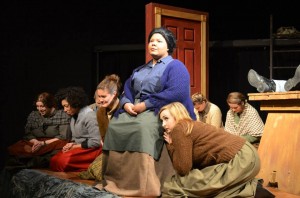Luciano Pavarotti said, “It is so important for people at a young age to be invited to embrace classical music and opera,” and the Shorter University students involved in the fall opera scenes are doing just that.
The fall opera scenes are set to open October 17, and the students involved have been working hard all semester to ensure wonderful performances. The operas in which the scenes come from include Don Giovanni, The Magic Flute and Le Nozze di Figaro by Mozart and Il Barbiere di Siviglia by Rossini, among many more. 
Hannah Swope, senior vocal performance major, is performing in three of the opera scenes, including Le Nozze di Figaro, Amahl and the Night Visitors and The Pirates of Penzance. This is not Swope’s first time being involved in opera scenes, so she is well accustomed to the sometimes stressful and demanding rehearsals building up to the performances.
“Those rehearsals tend to be long and tedious, but necessary to reach the ultimate goal of having a total blast being someone else on stage for a few hours,” Swope said.
Although these demanding yet essential rehearsals are common to Hannah Swope and the rest of the upperclassmen involved in the opera scenes, they are new to freshman vocal performance and communication double major, Mary Saintfort.
Saintfort is performing in many of the opera scenes, including Mozart’s The Magic Flute. Although timid at first, Saintfort has adapted to opera rehearsals with the help of the upperclassman also performing in the scenes.
“Working with each of them has been a blessing and each have taught me more about opera in this beautifully challenging experience,” Saintfort said.
Dr. Johnathan Ten Brink, a music professor at Shorter University and the director of the opera scenes, has brought new insights to the opera scenes this fall.
“Dr. Ten Brink has done a fabulous job showing all of the performers how to really connect with the music,” Swope said.
Dr. Ten Brink has not only overseen all the preparation for the scenes but has also integrated himself into each step of the process, including set building, costume design and musical rehearsals.
An interesting change Dr. ten Brink has made to the opera scenes this fall is to not perform the scenes as they normally would be performed.
“We’re not just doing the operas as they were originally intended; we’re doing them as something new and innovative,” Ten Brink said.
New styles and timelines are being incorporated to some of the scenes, including “90s grunge” and anime. These changes can help make the scenes more modernized and bring a new twist to classic opera.
Even though rehearsals can be challenging, they can also help the performers grow into their characters and truly understand what they are portraying.
Swope said, “The process of putting a show together becomes very exciting when you start to see everyone having some kind of an epiphany with their character or the music. It’s at this point that you can really begin to see a scene come to life on stage.”
Dr. Ten Brink has also noticed the changes in the ways the student performers connect with their characters and with each other.
“What I’m really proud of … is the growth that I have seen, as musicians, as actors, as colleagues for each other,” Ten Brink said.
It is clear that Pavarotti’s statement about delving into opera has impacted these student performers. Dr. Ten Brink believes the performances will show all the efforts that went into the productions and that each person in the audience will find something they enjoy due to the twists and talents that these opera scenes will bring.
